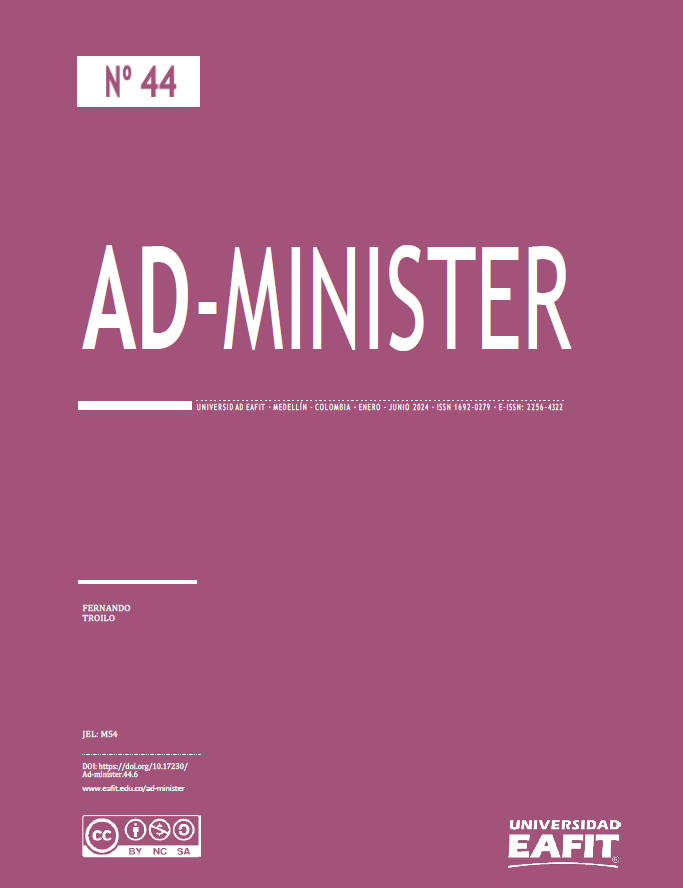The employee’s perspective on post-pandemic hybrid work in an emerging market
Main Article Content
Keywords
Hybrid work, Remote work, Virtual work, Work-life balance
Abstract
The objective of this research was to know the opinion of employees about their current work modality, the opportunities for improvement perceived in this modality and the preferences regarding the desired work modality. To meet the objective, a quantitative approach was implemented by conducting 268 surveys of employees of private companies in the AMBA region of Argentina. The results show that, although the prevailing current modality is the hybrid one with a scheme established by the company, the modality chosen with preference is the free type without a guideline established by the organization. This points out the importance that flexibility today has in the work modality of organizations in emerging markets to attract and retain talent. Finally, areas of opportunity for improvement appear regarding the new hybrid work modalities in these types of markets, related mainly to the need to promote employees' wellness in the search for a better balance between work and personal life.
Downloads
References
Berruti, F.; Ho, G.; Kirschner, P.; Morris, A.; Norman, S.; Roth, E. (2022). How virtual work is accelerating innovation, McKinsey & Company. https://www.mckinsey.com/capabilities/operations/our-insights/how-virtual-work-is-accelerating-innovation
Buitrago Botero, D. (2020). Teletrabajo: Una oportunidad en tiempos de crisis. Revista Ces. 11 (1), 1-2. https://revistas.ces.edu.co/index.php/derecho/article/view/5620
Butragueño, L. et al. (2021). Simulation during COVID-19 pandemic in the Spanish pediatric intensive care units: New challenges in medical education. Anales de Pediatria, 95 (5): 373-375. https://doi.org/10.1016/j.anpedi.2021.06.007
Campos, A. (2021). Teletrabajo y derecho a la desconexión digital. Relaciones Laborales y Derecho del Empleo. 9 (1). 1-34. https://ejcls.adapt.it/index.php/rlde_adapt/article/view/962
Castellano, M. et al. (2017). El teletrabajo como estrategia laboral competitiva en las PYME colombianas. Espacios, 38 (31). https://www.researchgate.net/publication/322493981_El_teletrabajo_como_estrategia_laboral_competitiva_en_las_PYME_colombianas
Fan, W.; Moen, P. (2023). The Future(s) of Work? Disparities Around Changing Job Conditions When Remote/Hybrid or Returning to Working at Work. Work & Occupations, 1. http://dx.doi.org/10.1177/07308884231203668
Fernández – Lozano, I. (2023), El teletrabajo y las fronteras entre la vida y el trabajo durante la pandemia. Revista Española de Investigaciones Sociológicas. 182 (1), 23-44. https://doi.org/10.5477/cis/reis.182.23
García Viña, J. (2021). Hacia un modelo híbrido de prestación de trabajo: smart working. Revista Internacional y Comparada de Relaciones Laborales y Derecho del Empleo, 9 (1): 449-473. https://doi.org/10.1111/ilrs.12216
González-González, I., Martínez-Ruiz, M. P.; Clemente-Almendros, J. A. (2022). Does employee management influence the continued use of telework after the COVID-19 pandemic? Small Business International Review, 6(2), 1–12. http://dx.doi.org/10.26784/sbir.v6i2.537
He, J. et al. (2020). On being warm and friendly: the effect of socially responsible human resource management on employee fears of the threats of COVID-19. International Journal of Contemporary Hospitality Management, 33(1), 346–366. https://doi.org/10.1108/IJCHM-04-2020-0300
Hilberath, C.; Kilmann, J.; Lovich, D.; Tzanetti, T.; Balley, S.; Kaufman, E.; Khandelwal, B.; Schuler, F. and Woolsey, K. (2020). Hybrid Work Is the New Remote Work, Boston Consulting Group. https://www.bcg.com/publications/2020/managing-remote-work-and-optimizing-hybrid-working-models
Lorca, J. G.; Belli, S. (2023). Towards a Funambulist Leadership in Researchers Well-Being: Managing Equilibriums and Tensions in the Hybrid Work Era. Administrative Sciences (2076-3387), 13(2), 63. http://dx.doi.org/10.3390/admsci13020063
Mahipalan, M.; Sheena. (2015). Emerging Trends in Employee Engagement: A Review of Literature. OPUS: HR Journal, 6.1, 1-17. https://doi.org/10.21863/opus/2015.6.1.001
O’Brien, K. E.; Roach, K. N.; Haas, J. B. (2023). Listening to Employees to Confront Postpandemic Turnover. TIP: The Industrial-Organizational Psychologist, 60(4), 1–7. https://www.siop.org/ResearchPublications/ItemsofInterest/ArtMID/19366/ArticleID/7462/preview/true
Pärli, K. (2022). Impacts of Digitalisation on Employment Relationships and the Need for more Democracy at Work. Industrial Law Journal, 51(1), 84–108. http://dx.doi.org/10.1093/indlaw/dwaa029
Peiró, J.; Soler, A. (2020). El impulso al teletrabajo durante el Covid-19 y los retos que plantea. IvieLAB 1 (1), 1-10. https://umivaleactiva.es/dam/web-corporativa/Documentos-prevenci-n-y-salud/11.Covid19IvieExpress.El-impulso-al-teletrabajo-durante-el-COVID-19-y-los-retos-que-planteaf.pdf
Shodiq, S.; Syamsudin, S. (2019). Teacher identity reconstruction: Socio-anthropological study of javanese society. Cakrawala Pendidikan, 38(3), 477–489. https://doi.org/10.21831/cp.v38i3.26098
Suarez Villacis, A.; Bravo Leon, J. (2022). Transformación digital y su impacto en el trabajo colaborativo post pandemia Covid -19 en Ecuador. Revista tecnológica ciencia y educación Edwards Deming, 6 (1): 75-83. https://doi.org/10.37957/rfd.v6i1.91
Tapasco-Alzate, O.; Giraldo-García, J. (2018). Teletrabajo: Aspectos críticos para su implementación desde la perspectiva de los directivos. Proceedings of the LACCEI International Multi-Conference for Engineering, Education and Technology, (July): 19–21. https://doi.org/10.18687/LACCEI2018.1.1.221
Tapasco-Alzate, O.; Giraldo-García, J. (2020). Asociación entre posturas administrativas de directivos y su disposición hacia la adopción del teletrabajo. Información Tecnológica, 31(1): 149–160. https://doi.org/10.4067/s0718-07642020000100149
Tomasina, F.; Pisani, A. (2022). Pros y contras del teletrabajo en la salud física y mental de la población general trabajadora: una revisión narrativa exploratoria. Archivos de Prevención de Riesgos Laborales, 25 (2), 147-161. Ed. Epub. https://dx.doi.org/10.12961/aprl.2022.25.02.07
Tosca-Vidal, C.M. (2022). Teletrabajo en El Modelo Híbrido: Alternativa Para Las Organizaciones. Journal of Research of the University of Quindio, 34(2), 260–266. http://dx.doi.org/10.33975/riuq.vol34n2.934
Zafari, S.; Hartner-Tiefenthaler, M.; Koeszegi, S. (2019). Flexible Work and Work-related Outcomes: The Role of Perceived Organizational Alignment. Management Revue, 30(1), 63-92. https://doi.org/10.5771/0935-9915-2019-1-63


